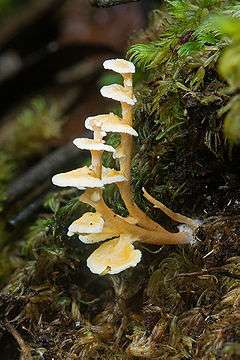Amylocorticiales
Amylocorticiales is an order of fungi in the class Agaricomycetes. The order was circumscribed in 2010 to contain mostly resupinate (crust-like) forms that have been referred to genera Anomoporia, Amyloathelia, Amylocorticiellum, Amylocorticium, Amyloxenasma, Anomoloma, Athelia, Athelopsis, Ceraceomyces, Hypochniciellum, Leptosporomyces and Serpulomyces.
| Amylocorticiales | |
|---|---|
 | |
| Ceraceomyces sublaevis | |
| Scientific classification | |
| Kingdom: | Fungi |
| Division: | Basidiomycota |
| Class: | Agaricomycetes |
| Subclass: | Agaricomycetidae |
| Order: | Amylocorticiales K.H.Larss., Manfr. Binder & Hibbett (2010) |
| Family: | Amylocorticiaceae Jülich (1981) |
| Type genus | |
| Amylocorticium Pouzar (1959) | |
Phylogenetics
| |||||||||||||||||||||||||||||||||||||||||||||||||||||||||||||||||||||||||||||||||||||||
| Phylogeny and relationships of Amylocorticiales ribosomal DNA sequences.[1] |
The order contains one of three assemblages of basal lineages of Agaricomycetidae that contain corticioid fungi; the others are the Jaapiales and the Atheliales.[1] Although several molecular studies have confirmed the placement of the Amylocorticiales in the Agaricomycetidae, its relationship with other higher-level taxa is not known precisely. Depending on the loci used for analysis, the order is supported as sister group to the Agaricales, or as sister to a clade that contains the Agaricales, Boletales and Atheliales.[2][3][4][5]
Description
Species in the Amylocorticiales form fruit bodies that are effused (stretched out flat like a film-like growth), effused-reflexed (stretched out but with edges curled up) to almost pileate (with a cap), or stipitate (with a stipe). They have smooth hymenophores that can be either merulioid (wrinkled with low, uneven ridges), irpicoid (with "teeth") or poroid (with pores). The hyphal system is monomitic (containing only generative hyphae) and all hyphae are nodose-septate (with nodes and septa). The cystidia are rare and when present, are tube-like and often nodose-septate. The basidia (spore-bearing cells) are mostly terminal but in one genus borne laterally on horizontal hyphae (pleurobasidia), invariably producing four spores. The basidiospores are smooth, thin-walled or thick-walled, ellipsoid, cylindrical or allantoid (sasuage-shaped), in most species amyloid. Taxa that do not exhibit amyloid reactions include Ceraceomyces, Podoserpula, Serpulomyces and Leptosporomyces septentrionalis. Species are saprobic on decaying wood or as plant parasites. Amylocorticiales typically cause brown rot or white rot.[1]
Genera

- Anomoporia
- Amyloathelia
- Amylocorticiellum
- Amylocorticium
- Amyloxenasma
- Anomoloma
- Athelopsis
- Ceraceomyces
- Hypochniciellum
- Irpicodon
- Leptosporomyces
- Plicaturopsis
- Podoserpula
- Serpulomyces
References
- Binder M, Larsson K-H, Matheny PB, Hibbett DS (2010). "Amylocorticiales ord. nov. and Jaapiales ord. nov.: Early diverging clades of Agaricomycetidae dominated by corticioid forms". Mycologia. 102 (4): 865–80. doi:10.3852/09-288. PMID 20648753.
- Binder M, Hibbett DS, Larsson KH, Larsson E, Langer E, Langer G (2005). "The phylogenetic distribution of resupinate forms across the major clades of mushroom-forming fungi (Homobasidiomycetes)". Systematics and Biodiversity. 3 (2): 113–57. doi:10.1017/S1477200005001623.
- Hibbett DS, Binder M (2002). "Evolution of complex fruiting-body morphologies in homobasidiomycetes". Proceedings of the Royal Society B: Biological Sciences. 269 (1504): 1963–9. doi:10.1098/rspb.2002.2123. PMC 1691125. PMID 12396494.
- Larsson K-H, Larsson E, Koljalg U (2004). "High phylogenetic diversity among corticioid homobasidiomycetes". Mycological Research. 108 (9): 983–1002. doi:10.1017/S0953756204000851. PMID 15506012.
- Larsson KH (2007). "Re-thinking the classification of corticioid fungi". Mycological Research. 111 (9): 1040–63. doi:10.1016/j.mycres.2007.08.001. PMID 17981020.